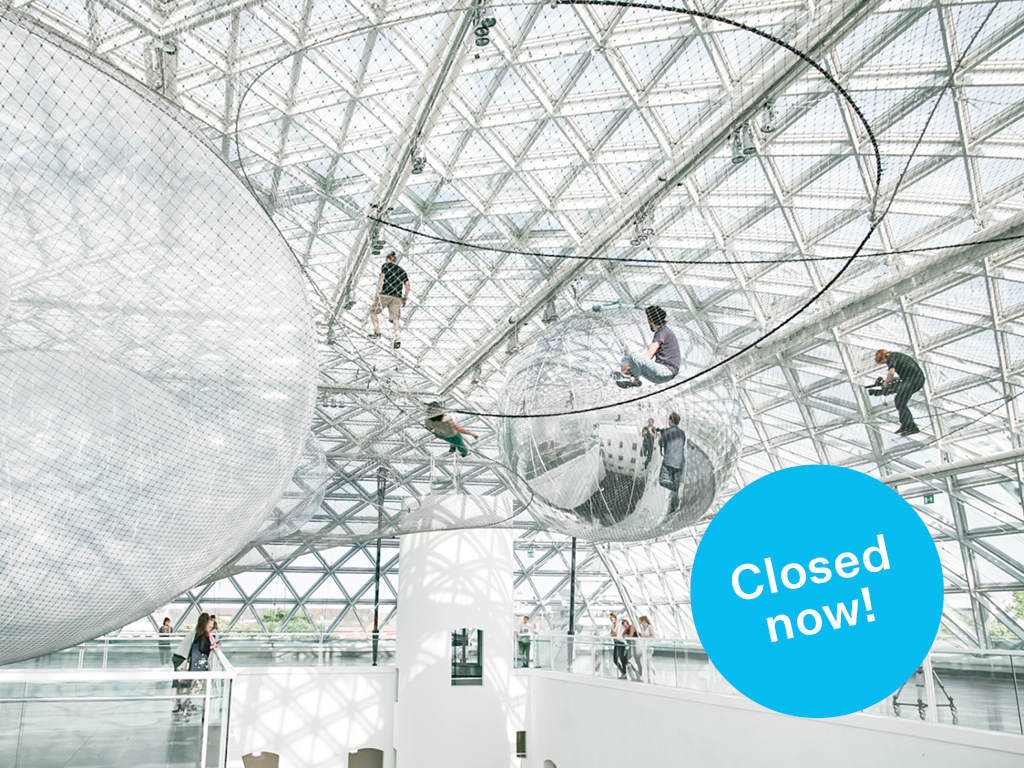After more than ten years and almost one million visitors, the team of the Kunstsammlung Nordrhein-Westfalen, together with the artist Tomás Saraceno, has decided to close and dismantle the web-like installation in orbit at K21. Originally planned for one year, the installation enjoyed great popularity—and stayed. Meanwhile, the ravages of time have taken their toll on the installation, making a complete overhaul necessary. The net is now closed due to technical reasons.
For a long time, the net-like installation was an integral part of K21 and a hotspot for all generations: The Kunstsammlung Nordrhein-Westfalen would like to thank the public for their loyalty and great interest in Saraceno’s in orbit and looks forward to many more encounters at K21.
Tomás Saraceno’s enormous spatial installation in orbit is a physically accessible work of art. The structure is made of virtually transparent steel mesh, interlaced on three levels that span the massive glass dome.
Five air-filled “spheres” are positioned within the 2,500-square-meter mesh structure. The installation evokes a surreal landscape, a sea of clouds, or outer space with its weightless planets.
Visitors are invited to enter and explore the installation by climbing. Those brave enough to venture inside can observe the museum visitors down below like miniature figures wandering through a model world. Conversely, from the piazza and the mezzanines of the Ständehaus, the people in the net seem to float in the sky. With a new VR (virtual reality) work, the artist has further developed the interactive component of in orbit.
AEROCENE: FREE THE AIR. “Orbit-s” For a Post-Fossil Fuel Era (2022)
The open-source VR set invites you to take off and yet remain on planet Earth. Lifted only by the air, warmed only by the sun, and carried only by the currents of the winds, you fly around the globe without any fossil fuels, emissions, solar panels, or lithium batteries.
Visitors are invited to enter the installation and explore it by climbing. Those brave enough to venture in can observe the museum visitors down below — miniature figures wandering thorugh a miniature-like world. From the piazza and the mezzanines of the Ständehaus, the installation’s visitors on the net appear to be floating in the sky.
Once several people enter the structure simultaneously, it is set to motion, altering the tension of the steel cables and distances between the three levels of the interlaced net. The floating space now becomes a vibrating web of relationships, resonances, and synchronous communication.
Like a spider in a web, visitors perceive the presence of others through vibrations. This echoes Saraceno's interest and research, carried out in his studio in Berlin, on new hybrid and superhuman forms of communication and co-habitation.
In terms of scale and discourse, "in orbit" is at the forefront of Saraceno's oeuvre. Even those who are reluctant to enter the structure, suspended high above an abyss, and who decide instead to explore the installation in exclusively visual terms, will find themselves gripped by archetypal emotions associated with themes of flying, falling, and floating.
"To describe the work means to describe the people that use it – and their emotions," explains Saraceno. Rarely does a work of art touch fears and desires of viewers so intensely, and alters the perspectives of those who decide to step into an airborne condition.
"in orbit" was planned by Saraceno together with engineers, architects, and biologists from 2011 to 2013, and it is one of the artist’s most elaborate installations. Despite the fact that the network construction alone weighs three tons, and the largest of the "spheres" 300 kg, the work, created specially to the spatial condition of the Ständehaus with a meticulous precision, is remarkably light: its fineness and stability hints to the structure of a spider's web.
For a number of years, the artist has been inspired by the intricate construction of spider webs, and has assembled the first three-dimensional hybrid spider web collection in the world. His research, intrigued by more-than-human worlds, studies web-building techniques and social group behavior of various spider species. The results of this inquiry have enriched his artistic practice by incorporating insights on the functionality, beauty and strength of webs into his works.
While the precise observation of nature and natural phenomena suggests the basis for Saraceno’s work, art-historical references, like of visionary architects Frei Otto or Richard Buckminster Fuller, are recognizable as well. Saraceno’s practice can be viewed as a constant research and ambition to propose and to realize utopian architecture that is well informed by environmental, social and mental ecologies. Each installation, including "in orbit", is a step forward to this large-scale visionary project, with an ultimate result: a floating city of the future.
Perceived as a response to the current troubling environmental crisis, the vision materializes in multiple recent actions, gathered together under the Aerocene project: experiments in science, community building and social engagement, performances and interdisciplinary dialogues, inviting to fly and float with one’s feet on the ground.
-
Mit freundlicher Unterstützung von
-
-
Medienpartner
-

-
Gefördert durch:
-


